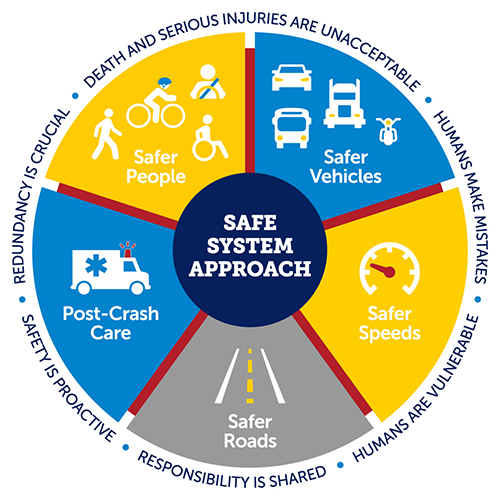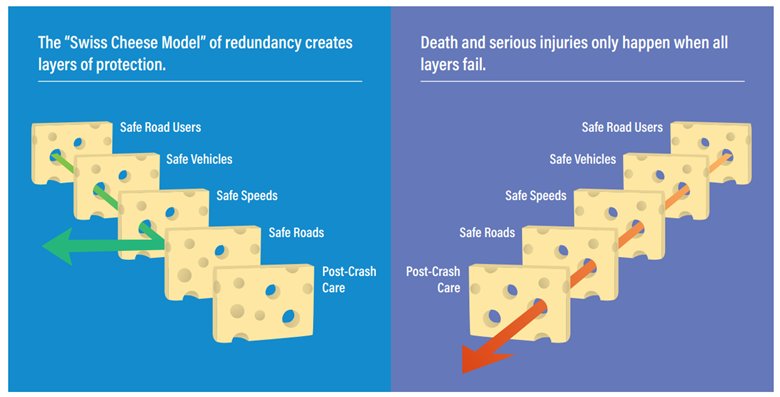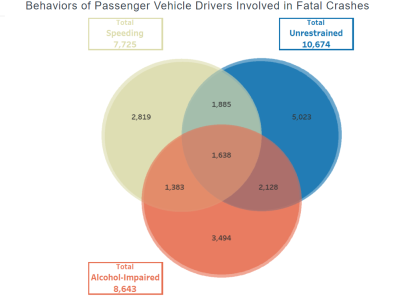The Safe System approach to roadway safety envisions eliminating fatal and serious injuries for all road users by creating a transportation system that accommodates human mistakes and keeps impacts on the human body at tolerable levels (Federal Highway Administration, 2021).
GHSA PolicyClick here to view GHSA's policies and priorities on the Safe System approach. |
First implemented abroad, the Safe System approach has been linked to substantial reductions in traffic-related fatalities. Countries that have adopted the approach have experienced large decreases in deaths, ranging from 47% in Australia to 80% in Spain (Johns Hopkins University, 2021). In January 2022, the United States Department of Transportation (U.S. DOT) released the National Roadway Safety Strategy, which calls for adoption of the Safe System approach as a proven tool to reduce traffic crashes, injuries and deaths.

The Safe System approach is based on six principles:
- Death/serious injury is unacceptable.
- Humans make mistakes.
- Humans are vulnerable.
- Responsibility is shared.
- Safety is proactive.
- Redundancy is crucial.
These six principles combine to create an approach with five key objectives:
- Safer people: Promoting safe, responsible driving behaviors and highlighting how speeding, impaired and distracted driving, and not buckling up can endanger both drivers and everyone on the road.
- Safer roads: Designing roads to mitigate human error, such as providing physical separation between vehicles, bicycles and pedestrians.
- Safer vehicles: Making new and improved safety technologies that help prevent crashes and mitigate injuries in the event of a crash available in more vehicles.
- Safer Speeds: Promoting safer speeds on all roadways through a combination of roadway design, appropriate speed-limit setting, targeted education, outreach campaigns and enforcement.
- Post-Crash Care: Enhancing the survivability of crashes through faster access to emergency medical care, while creating a safe working environment for first responders and preventing secondary crashes through robust traffic incident management practices.
The Safe System approach is a shift from conventional road safety thinking because it focuses on both human mistakes and human vulnerability by designing systems with many redundancies. This creates a multi-layered safety net, so that if one countermeasure fails, another will help prevent a crash or, in the event of a crash, lessen the likelihood of serious injury or death. This safety net includes the proven countermeasures of equitable enforcement of traffic safety laws; more and better designed infrastructure that protects all road users, especially people not in motor vehicles; outreach and engagement in all communities; vehicle technology that helps mitigate dangerous driving behaviors; and improved and expanded emergency medical services including training in bystander care.

GHSA Support of the Safe System Approach
GHSA strongly supports the Safe System approach as a comprehensive tool to reduce traffic crashes, injuries and deaths on U.S. roadways. In 2023, GHSA members adopted a new version of the association's Policies and Priorities, which cement our support of the Safe System approach and commitment to strengthening partnerships with other organizations and agencies committed to preventing traffic violence.
Our additional actions include but are not limited to:
- Issuing a report on the role of behavioral safety in the Safe System approach and identifying specific ways a State Highway Safety Office (SHSO) can support a Safe System.
- Prioritizing equity in traffic safety by making recommendations in 2020 to fight racism in traffic enforcement, researching and raising public awareness of the disproportionate impact of traffic violence on people of color and identifying barriers to more equitable traffic safety programs and how to overcome them.
- Highlighting the Safe System approach in a widely attended (in-person and online) General Session at the 2022 GHSA Annual Meeting in Louisville, Ky. The 2023 Annual Meeting featured a panel discussion examining the progress made – and what needs to be done – to implement the Safe System approach in the U.S.
- Tracking pedestrian fatality data to identify short- and long-term trends, shining a spotlight on the safety crisis for people on foot, and identifying and promoting how the Safe System can be applied to improve safe walking.
- Exploring how law enforcement officials, other first responders and crash scene investigators can better prepare for automated vehicle technology and outlining curriculum recommendations to improve training on rapidly changing safety protocols.
- Highlighting the unique dangers of rural roads in the GHSA report, America’s Rural Roads: Beautiful and Deadly. The report examines how risky driving behaviors, a lack of safety resources, simpler roadway infrastructure and poor emergency medical services are contributing factors in rural road deaths and how the Safe System approach can be applied in rural areas.
Featured Initiative
Youth Active Transportation Safety Grant Results: Pennsylvania
In 2022, the Pennsylvania Department of Transportation (PennDOT) was awarded funds from the National Road Safety Foundation and GHSA to pilot a Safer Walking Routes to School initiative at Iroquois Elementary School with the United Way of Erie County.
Read More



